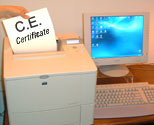
| Save and Share these Great Ideas... |

Healthcare Training Institute - Quality Education since 1979
CE for Psychologist, Social Worker, Counselor, & MFT!!
Section 4
Track # 4 - Abusive Therapy - A Story of Professional Manipulation and Mystique
Question 4 | Test | Table of Contents | Printable Page
Read content below or click FREE Audio Download
to listen
Right click to save mp3
In
the case of the power-abusing therapist, a second key to the pattern is that the
therapist is usually also going through a life crisis and emotional difficulty
that seriously impairs his or her judgment.
Let's focus more now on the case of Mary. Mary shared with me that her therapist stated feeling "trapped in his marriage due to having two children he felt 'talked into' by his wife."
3-Step Progression in the Case Study of Mary
![]() #1. Meeting His Own Needs - Instead of the Client's
#1. Meeting His Own Needs - Instead of the Client's
However,
with Mary, the balance of power shifted to unprofessional conduct when the therapist's
responsibility to act only in the client's best interests, gradually began to
reframe or reshape the relationship in a way that allowed him to meet his own
(rather than Mary's) needs.
Some clients or patients, as you might guess, quickly perceive that they are being treated inappropriately and terminate the therapy relationship. However, others, like Mary, get trapped and may stay in exploaitive or abusive client-therapist relationships. For a time, Mary felt wonderful, viewing herself as special and feeling very nurtured, cared for, and cared about, but obviously what was really happening was quite different.
The professional's manipulation of the situation, combined with his mystique so to speak, and the power imbalance of the professional relationship made the situation more complicated. Combine this with Mary's vulnerability and you can see what kept her in an emotionally detrimental situation. This situation, clearly undermined her mental health and stifled her emotional growth. In addition, needless to say, Mary was not working on her problems or difficulties regarding adjustment to her divorce that took her to the professional in the first place.
![]() #2. How the Abusive Therapy Relationship Ended
#2. How the Abusive Therapy Relationship Ended
You
may be wondering, how Mary's abusive therapy relationship ended. When she arrived
early for an appointment one day and observed a long embrace between her therapist
and another female client, she began to see the true picture and realized the
relationship was damaging her and that she must leave.
However, terminating the relationship did not end Mary's problems. She was left with even more difficulties and stress than when she started. Now she had the after-effects of a sexual post-traumatic stress disorder.
Many other obstacles also remained, not the least of which was the lack of support from others in her life. Mary's mother felt that she should have known better and viewed her as merely having had an affair with a married man. Because of her mother's comments, Mary, a 35 year-old, was unable to gather the courage to seek out added help from friends and relatives who may have been supportive. Mary blamed herself and felt ashamed
![]() #3. Finding a Therapist She Could Trust
#3. Finding a Therapist She Could Trust
As
you might guess Mary was left with major difficulties regarding trust, and was
at first unable immediately to seek further therapy after the incident. When
Mary began trying to understand and heal from the damage done to her, she had
yet another hurdle to face which was that of finding a therapist she could trust.
Mary had received my name via a word-of-mouth recommendation.
Five years after seeing the abusive therapists, Mary had moved twice and came to me blaming herself and feeling deeply ashamed. Her presenting problem was an inability to get along with co-workers, as well as to sustain a long term relationship following her divorce.
QUESTION 4
What are two hurdles that remain after a client leaves the abusive relationship?
To select and enter your answer go to Test.
Test for this course
Forward to Section 5
Back to Section 3
Table of Contents
Top